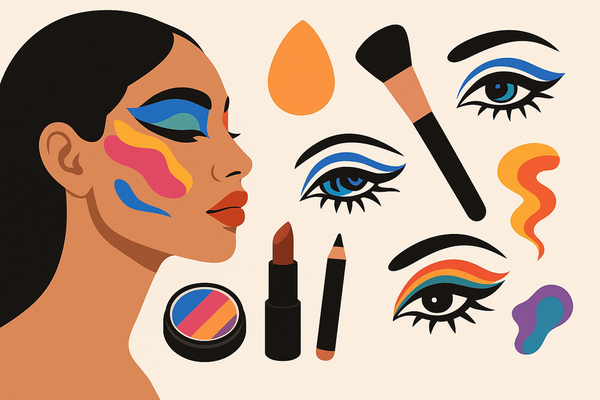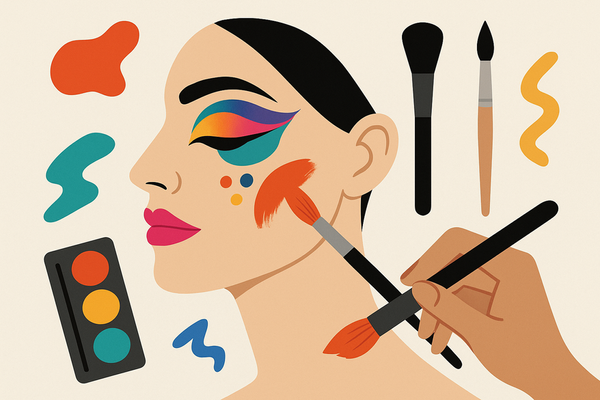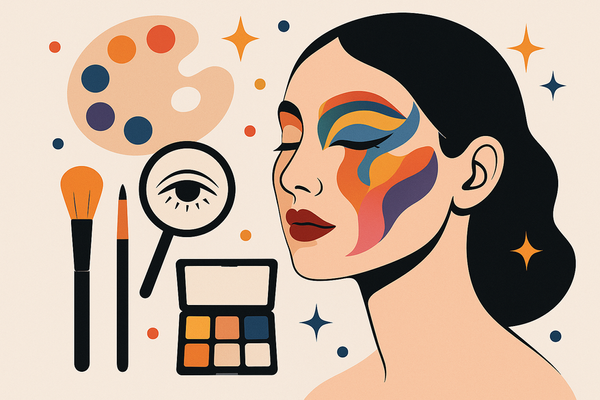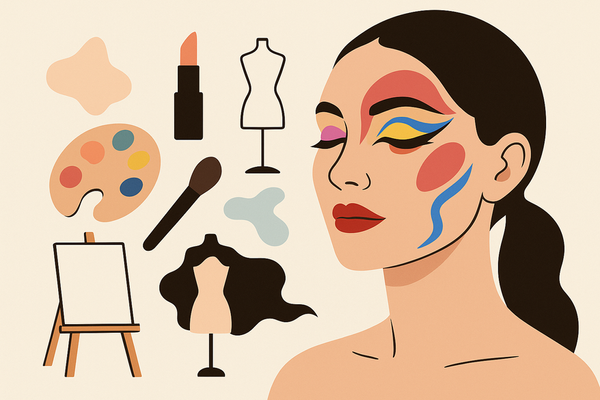Exploring Creative Makeup Designs: Step-by-Step Insights
Discover creative makeup designs that blend art, innovation, and self-expression. Get step-by-step insights, practical guidance, and trend inspiration.
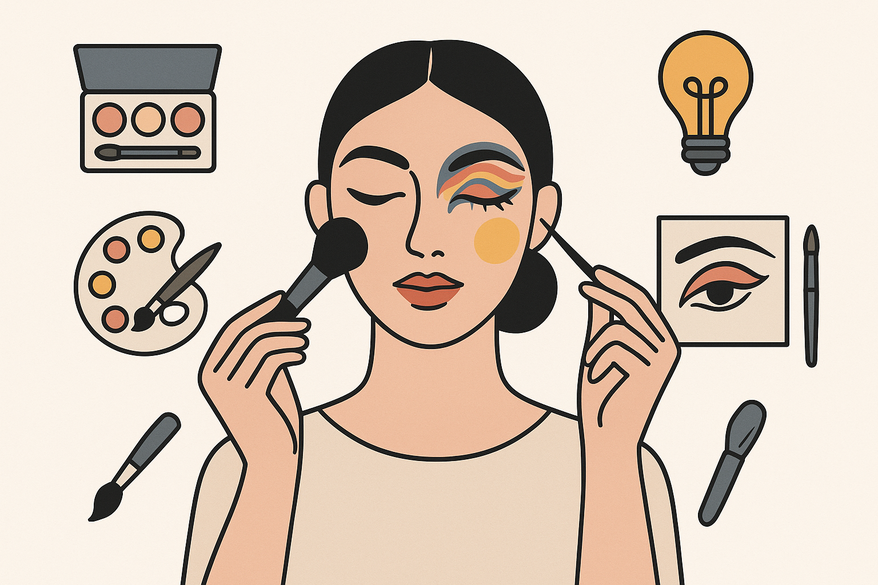
Estimated reading time: 12 minutes
Key Takeaways
- Creative makeup transforms the face into an artistic canvas using bold colors, textures, and sculptural elements.
- Influences include fine art, fashion, cultural heritage, and cutting-edge technology.
- Essential tools range from precision brushes and airbrush systems to silicone prosthetics and multimedia finishes.
- Key techniques involve layering, contouring, airbrushing, and seamless prosthetic blending.
- Safety measures—such as patch tests, gentle removal of glitters, and proper skincare—are crucial.
- Step-by-step tutorials and case studies help practitioners master graphic neon eyeliner and hyper-realistic SFX wounds.
Table of Contents
- Introduction
- Understanding Creative Makeup Designs
- Exploring Different Styles and Trends
- Tools, Techniques, and Materials
- Step-by-Step Tutorials & Case Studies
- Overcoming Challenges & Common Mistakes
- Conclusion & Additional Resources
- FAQ
Introduction
Creative makeup designs are artistic cosmetic applications that go far beyond conventional beauty routines, transforming the face into a dynamic canvas for bold self-expression, storytelling, and visual impact. These avant-garde looks prioritize transformation, drama, and narrative over subtle enhancement—often employing vivid color palettes, unconventional textures, sculptural elements, and imaginative compositions. Innovation and personalization drive modern makeup artistry. Today’s artists integrate tech-enhanced products, hyper-realistic special effects (SFX), and eco-friendly materials tailored to individual style and cultural influences. For an AI-driven perspective on avant-garde artistry, and you may also find additional techniques to elevate your work. The objective of this guide is to inform readers about the breadth and depth of creative makeup designs, providing practical guidance, trend insights, and inspiration for both aspiring artists and enthusiasts.
Understanding Creative Makeup Designs
Definition and Scope
Creative makeup designs treat the face as a three-dimensional work of art, using dramatic color palettes, graphic lines, 3D textures, and multimedia finishes. They rely on color theory, composition, and technical precision to craft looks that range from ethereal gradients to surreal sculptures.
Historical Evolution and Trends
- Ancient origins: Ritual face painting in cultures from Egypt to Africa.
- Theatrical roots: Stage and film makeup innovations in the early 20th century.
- Fashion editorial: Visionaries like Alexander McQueen pushed boundaries with dramatic face art in magazines and runway.
- Social media impact: Instagram and TikTok turned hobbyists into influencers, accelerating trend cycles and democratizing avant-garde techniques.
Influences on Creative Makeup Designs
- Fine art: Painterly motifs, sculptural shadow play.
- Fashion: Runway silhouettes, editorial concept shoots.
- Cultural heritage: Tribal patterns, henna and ink motifs.
- Technology: Advanced prosthetic materials, airbrushing, digital design tools enabling hyper-realistic SFX. Tools like Makeup Check AI can provide virtual try-ons and trend insights.
Exploring Different Styles and Trends
Style Overview
- Fantasy: Whimsical motifs like butterfly-wing eyes or iridescent mermaid scales.
- Avant-Garde: Bold shapes and color blocking—think graphic eyeliner arcs and surrealist face maps.
- Seasonal Themes: Event-specific art—pumpkin-carved contour for Halloween, rainbow glitter tears for Pride.
- Optical Illusion: Transformative tricks—“melted” makeup effects, animal mimicry on eyelids.
- Hyper-Realistic SFX: Film-grade prosthetics and textures—zombie wounds, alien skin details.
Current Trends
- Ultra-thin prosthetics with airbrushing for seamless, lifelike effects.
- Graphic eyeliner and vibrant color blocking dominating editorial and festival looks.
- Neon brights and surrealist motifs inspired by ’80s aesthetics and dreamscape shapes.
- Tech-integrated and eco-friendly products reflecting sustainable innovation.
- Viral challenges (e.g., #NeonEyeshadowChallenge) fueling community creativity.
Tools, Techniques, and Materials
Essential Tools & Products
- Brushes & Sponges: Precision application and seamless blending.
- Ultra-fine Liquid Liners: Crisp graphic shapes and intricate details.
- Multi-use Cream Palettes: Versatile color options for layered work.
- Airbrush Systems: Smooth gradients and hyper-realistic textures.
- Silicone Prosthetics: Three-dimensional accents and realistic skin textures.
- Glitter, Gems & Holographic Powders: Multimedia finishes and sparkle.
- Digital Sketch Pads & Printable Face Charts: Plan and visualize designs before application.
- Setting Sprays & Flexible Adhesives: Longevity, safety, and secure embellishments.
Advanced Techniques
- Airbrushing: Ultra-fine mist of pigment for seamless transitions.
- Layering: Build pigments in thin successive layers for depth.
- Contouring: Dramatically alter perceived facial structure with shadows and highlights.
- Prosthetic Application: Blend silicone edges using alcohol-activated palettes and airbrush techniques.
- Glitter/Gem Application: Secure with skin-safe adhesives; remove gently with oil-based removers.
Safety & Experimentation Tips
- Patch-test new pigments and adhesives on the inner wrist.
- Remove glitters and gems with oil-based makeup remover to avoid irritation.
- Start with simple designs; increase complexity as skills improve.
- Keep skin clean and moisturized to reduce sensitivity under heavy products.
Step-by-Step Tutorials & Case Studies
Tutorial – Graphic Neon Eyeliner
- Concept & Prep: Sketch the eyeliner design; cleanse and prime eyelids.
- Base Application: Apply a white or neutral base to intensify neon pigments.
- Layering: Pack neon pigments onto lids with a damp sponge, blending for a smooth ombré.
- Detail Work: Draw sharp lines with an ultra-fine liquid liner.
- Embellishments: Affix rhinestones or glitter with tweezers and skin-safe adhesive.
- Setting: Mist with professional setting spray for lasting wear.
Case Study – Hyper-Realistic SFX Wound Makeup
- Planning: Choose or sculpt a silicone prosthetic based on reference images.
- Application: Adhere and blend edges using alcohol-activated palettes and an airbrush.
- Coloring: Layer reds, purples, and browns to create depth and bruise effects.
- Finishing: Add blood effects with gelatin-based products; seal edges with flexible adhesive.
Artist Insights
- Mimi Choi: “Patience and precise planning are key. Start each design with a detailed sketch.”
- Tal Peleg: “Draw inspiration from art, nature, fashion, and global cultures to keep work fresh.”
Recommended Learning Resources
- YouTube channels: “Festival Face Art,” “Avant-Garde Makeup” for visual guides.
- Instagram/TikTok hashtags: #CreativeMakeupDesigns, #FaceArtTutorial for inspiration.
- Workshops & Masterclasses: Cinema Makeup School’s SFX and face art intensives.
- Online courses: Skillshare classes, local beauty academies for structured learning.
Overcoming Challenges & Common Mistakes
Potential Pitfalls
- Overcomplicating designs too early can lead to frustration; master basics first.
- Non-cosmetic grade glitters or adhesives risk skin irritation or injury.
- Poor prosthetic blending breaks the illusion; practice on mannequins.
Troubleshooting Tips
- Always perform a patch test before full application.
- Adapt designs to different face shapes—elongate for round faces, soften for angular features.
- Tailor product choice to skin type: extra setting spray for oily skin, additional hydration for dry skin.
- Consider final reveal context (photography vs. live performance) when choosing finishes.
Continuous Improvement
- Document your process with progress photos to track growth.
- Seek constructive peer feedback via online communities.
- Revisit and refine challenging techniques until they become second nature.
Conclusion & Additional Resources
Creative makeup designs merge art, technology, and personal expression through bold colors, innovative textures, and imaginative concepts. Mastery requires understanding foundational tools, staying current on trends, and drawing inspiration from diverse artistic, fashion, and cultural sources. Embrace experimentation and continuous learning; the most memorable looks emerge from pushing boundaries and adapting new technologies and eco-friendly innovations.
For further study, explore online communities on Instagram, TikTok, and YouTube, enroll in intensive workshops at Cinema Makeup School or Skillshare, and consult industry reports and design encyclopedias for ongoing inspiration.
FAQ
What is creative makeup design?
Creative makeup design is the art of transforming the face into a visual masterpiece using unconventional colors, textures, and sculptural elements beyond traditional beauty techniques.
Which tools are essential for beginners?
Start with basic brushes, a multi-use cream palette, ultra-fine liners, and a good primer. As you progress, add airbrush systems and simple prosthetics.
How do I ensure safety when using prosthetics and glitters?
Always patch-test new materials, use skin-safe adhesives, remove embellishments with oil-based removers, and keep skin moisturized to prevent irritation.
Where can I find tutorials and community feedback?
Explore YouTube channels like “Festival Face Art,” hashtags such as #CreativeMakeupDesigns on Instagram/TikTok, and join online forums or workshop communities.
How can I improve my skills over time?
Document each project with photos, seek peer critiques, revisit challenging techniques, and practice regularly on face charts or mannequins.

